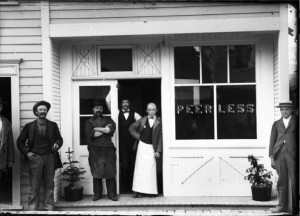The Wild Animal Meat Market in Dawson in 1900, James is seen in his butcher’s apron in front of the store.
James Johnston Hales, born in 1870 in Toronto, was the eldest son of John and Ann Hales. He spent his early life in Chatham working in his father’s butcher shop. In 1897 at the age of 27 he went to the Klondike for nearly two years in search of precious gold. Some highlights of his trip – taken from the Chatham newspaper, the Evening Banner, 1899, – include:
“James Hales left Seattle, Washington for Skagway in December 1897 taking some 3000 pounds of meat that he hoped to sell. This made history as it was the first meat transported by horses and packed on men’s backs. He located two miles from the Chilicoot Pass at Lake Lindeman and opened a grocery store, meat market and post office. The shipment of meat didn’t prove very profitable. Most of the people who managed to get that far were short of money and they couldn’t afford to buy meat. Also, they hadn’t got tired of eating pork and beans.”
“On June 15, 1898 he sold his business and bought a 27 foot boat to paddle down the Yukon River where they had to shoot the famous White Horse rapids. After a treacherous and thrill packed trip he arrived in Dawson City on the 30th of June. He spent the next five months prospecting. “My companions and myself just put packs on our backs and went into the gold fields. We lay all night with our packs for pillows wherever night overtook us.” As their boat was number 13706 many prospectors had set out ahead of them. The mosquito plague, black ants, poor diets, and hard work in the Bear Mine on Elderado Creek didn’t stop him from staking several claims. On arrival in Dawson City he opened a butcher business and operated it for ten months serving a population of 20,000 people.”
“The trip from Chatham to the Yukon can now be made in two weeks,” said John Hales in 1897. Today you could make it in one day or two at the most. On his return trip to Chatham he spent a few days in Seattle, arriving home well and hearty, stating that he intended to go back next year, 1899, which he did. “The Klondike is a great place and I like the climate,” said James Johnston Hales in 1899. He brought home a number of gold nuggets which he was very proud of. An exceedingly large and beautiful one of considerable value he gave to his mother Ann Johnston Hales.
His daughter Alice was born in 1900 in Dawson. The Hales family moved to Hayward, California where J.J. also ran a butcher shop until his untimely death in a railroad accident in 1934:
“Apparently Unaware of Approach of Locomotive James Johnston Hales of Cherry Way was killed this morning when his auto was struck by an Western Pacific freight train on the road crossing on Cherry Way. Apparently unaware of the approach, Mr. Hales was thrown from his machine in the impact and died a few minutes later before an ambulance could take him to a hospital. He had a broken leg and arm, a basal fracture of the skull and internal injuries.
It was reported that two cats were supposed to have been in the car with Mr. Hales. They were also killed by the crash.
Mr. Hales’ son Waller H. Hales told investigating officers that his father drove each morning to his butcher shop. He drove for some distance from his home in second gear. That fact may account for his apparent failure to hear the train as there were no skid marks. There were no skid marks or other indications that he tried to avoid the crash according to Capt. L. A. Eike and Officer George of the state highway patrol. Besides the son, Mr Hales is survived by his wife Mrs Laura Hales. He was born in Toronto, Canada. Funeral arrangements await the arrival of a daughter from the east.”
Hayward Daily Review , August 30, 1934; family websites.










